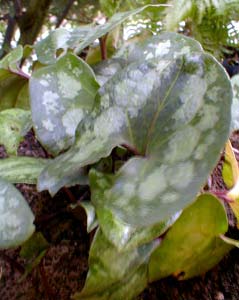 Marbled Chinese Wild Ginger;
Marbled Chinese Wild Ginger;
or, Splendid Asarum
Asarum splendins is an Asian ornamental ginger that somewhat resembles another Chinese asarum in our garden, A. delevayi, in that it has large leathery leaves, with moderately rapid growth upon thick spreading rhizomes.
Its distinguishing factor is disguinguishing indeed, in that A. splendins has pointier broad-arrowhead or heart-shaped leaves, & rather than the faint mottling of A. delevayi it has a more intense silvery-white marbling that makes it much the most extravagant of several Chinese asarums presently on the market. It is the impressive beauty of the leaves that won it a species name meaning "Splendid."
The species was introduced to western gardening about 1993. It reached us due to the combined resources & efforts of Asian plant explorers Dr. James W. Waddick of Kansas & Barry Yinger of Asiatica International Rare Plants Resources, with discovery & production support from the Raulston Aboretum (North Carolina) & Hines Horticulture (California).
Asiatica Rare Plant Resource offers more varieties of asarums than anyone I'm aware of. Waddick's & Yinger's choices of Asian jack-in-the-pulpits also grace our gardens.
A. splendins is fully evergreen to about ten degrees F., but will become partially deciduous in colder zones. Ours is planted in deep shade in a jack-in-the-pulpit garden, where it provides a green liveliness when the pulpits are not visible.
It grows six or eight inches tall suppressing all weeds under its huge leaves, & will spread out on thick white rhizomes, which in Asia are used as a substitute for true ginger. Eaten raw, or used medicinally, it has the potential of damaging the liver & kidneys, so is banned for internal use in many countries.
All asarums are slow to spread, but this one is just a bit more vigorous than the majority, so I may actually be able to test the culinary value of the root someday, without feeling that I'm spoiling an ornamental patch. If I do work up the nerve, I'll be cooking the devil out of it beforehand, to break down the root's dangerously toxic aristolochic acid.
It produces two-inch deep purple bell-flowers that hide underneath the leaves lying right on the ground, inviting pollination by crawling insects, especially beetles & ants.
Asarum delevayi